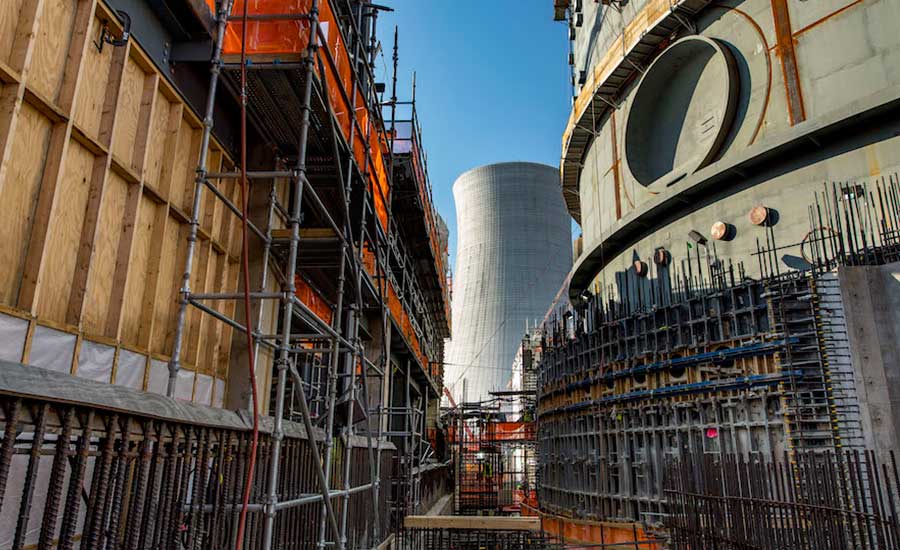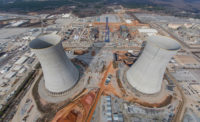The utilities powering the United States’ nuclear renaissance scrambled to save two over-budget, behind-schedule expansion projects as lead contractor Westinghouse Electric Co. announced March 29 that it had filed for Chapter 11 bankruptcy protection. The bankruptcy filing had been much expected in recent weeks following parent company Toshiba Corp.’s February announcement that it would incur an earnings writedown of more than $6 billion due to financial losses from its two U.S. nuclear contracts.
According to Westinghouse’s bankruptcy filing in U.S. District Court in New York City, the biggest creditors are Fluor, at $193.9 million, and CB&I, at $145 million. That amount is a deferred purchase price from Westinghouse's 2015 acquisition of CB&I's nuclear construction operations.
Additionally, court filings indicate the contractor estimated that it would cost an additional $6.1 billion to complete both projects on schedule. “These preliminary estimates of approximately $6.1 billion could not be sustained by Westinghouse,” the company noted in its bankruptcy documents. The company was operating under fixed-price contracts with both project owners.
In its statement announcing the move, WEC said it would “undertake a strategic restructuring as a result of certain financial and construction challenges in its U.S. AP1000 power plant projects,” which included obtaining $800 million in debtor-in-possession financing from a third-party lender. The contractor also announced that it had reached an agreement with project owners “to continue these projects during an initial assessment period” of approximately 30 days.
| Westinghouse announced that it had reached an agreement with project owners to continue working on the two big nuclear power jobs. |
That DIP financing is “not being used to fund the U.S. AP1000 projects,” added Sarah Cassella, spokesperson with WEC. Both Georgia Power and SCANA Corp.—and subsidiary South Carolina Electric & Gas—reported that each was reviewing updated schedule and cost estimates for their respective projects before determining a course of action. The Georgia and South Carolina projects both add two nuclear units to existing sites, with each pair of units featuring respective in-service dates of 2019 and 2020.
In a statement, Jacob Hawkins, spokesperson with Georgia Power, majority owner of the Plant Vogtle nuclear expansion, noted: “We are currently conducting a full-scale schedule and cost-to-complete assessment to determine what impact Westinghouse’s bankruptcy will have on the project and … the best path forward.”
Lonnie Carter, president and CEO of V.C. Summer project co-owner Santee Cooper, stated: “This agreement will provide SCE&G and Santee Cooper the time necessary to perform due diligence related to cost and schedule. It gives us critical direct access to resources and information that Westinghouse had not provided us to date, which will be important as we plan for the future of the project.”
Westinghouse’s court documents provided some detail about its revised cost and schedule estimates that the utilities will be reviewing. In examining the costs to complete the V.C. Summer and Vogtle projects on schedule, “Westinghouse and Fluor estimated that completion of the … projects on schedule could require $3.7 billion in additional labor costs…. Equipment prices and vendor costs associated with the building of specific components could drive up costs by an additional $1.8 billion. Finally, additional risk and contingency planning—including warranty and fee claims—could increase costs by approximately $600 million.”
Utilities Considering All Options
Meanwhile, executives with SCANA and SCE&G—co-owners of the V.C. Summer Nuclear Station expansion in South Carolina—informed analysts that the utilities were considering all options, including abandonment, as they review their project’s recently updated schedule and cost estimates. Those options include: continuing with construction of both new units; delaying or abandoning construction of one unit; or abandoning the project altogether.
However, “Our commitment is still to try to finish these plants,” SCANA CEO Kevin Marsh told analysts. “The least-preferred option, realistically, is abandonment, because it won’t achieve our objectives. If we just cancelled these plants, we’d still have a generation issue.”
Marsh added that, though SCANA has not yet validated WEC’s latest estimate, “At this time, we expect that the resources available form Westinghouse and Toshiba, including its parental guarantee, are adequate to compensate us for the Westinghouse estimate of additional cost.
“If continuing with construction is not determined to be the most prudent path forward for either or both of the units,” Marsh continued, “we will look to exercise the abandonment clause of the Base Load Review Act.”
While Westinghouse’s future status on the projects appears uncertain, the South Carolina utility announced that, for now at least, “Fluor will continue as the construction manager during this period and they continue to work towards completion of the units.” That was notable because just prior to Westinghouse’s bankruptcy filing, construction manager Fluor Enterprises submitted liens of $105 million and $60 million against Georgia Power and SCE&G, respectively. The contractor had joined the Vogtle and V.C. Summer projects in January 2016.
"Fluor continues to work on the projects at both sites at the request of the owners," the company said in a statement. "Fluor expects that it will be compensated by the owners of the projects for the previous and ongoing work at both projects."
Both utilities are expected to report the findings of their reviews to their respective state public service commissions before determining a final decision on the fate of the nuclear projects.




